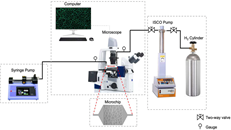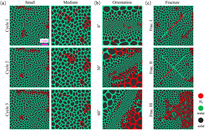Microfluidic Experiments on Hydrogen Behavior in Heterogeneous Rocks during Underground Hydrogen Storage in Saline Aquifers
Ruichang Guo, Reza Ershadnia, Hongsheng Wang, Seyyed A. Hosseini*, Qingqi Zhao
Fuel, 2025, 391, https://doi.org/10.1016/j.fuel.2025.134731


Study Summary
Hydrogen (H₂) plays a crucial role in the global transition to a low-carbon economy. Underground H₂ storage (UHS) provides a practical solution for large-scale storage of H₂ generated with renewable energy. Due to the complexity of subsurface environments, understanding the behavior of H₂ in porous rocks remains a pressing need. This study investigated the displacement process of H₂ and water in heterogeneous or fractured porous media which is a common characteristic in geologic formations. Micromodels were fabricated to reproduce the H₂-brine-rock system in saline aquifers for UHS. Three groups of micromodels were fabricated: homogeneous porous media, layered heterogeneous porous media, and fractured porous media. Three cycles of injection and withdrawal were performed for each scenario. The results suggested that for homogeneous porous media with larger pore sizes were beneficial for increasing H₂ storage capacity and reducing residual H₂. In layered heterogeneous porous media, the heterogeneity structure dominated the displacement process. The H₂ accumulated in larger pores and penetrated low-permeability layers through preferential channels. The residual H₂ was much larger than homogeneous porous media and can be trapped on both the upstream and downstream sides of the low-permeability layer. In fractured porous media, the fracture with a width larger than the average pore size of the porous medium acted as a high-connectivity channel which changed the flow path of fluids. The H₂ storage capacity and residual H₂ were also increased. The fracture with a width smaller than the average pore size of the porous medium acted as a barrier in the withdrawal process and trapped up to three times more H₂ after the withdrawal process. The findings provided novel insights on the role of layered heterogeneity structure and fractures in the cyclic injection-withdrawal operations and offered guidance in the site selection and operation optimization for UHS in saline aquifers.
Why is this research important and why do the results matter?
- Laboratory observations were conducted on the pore-scale behavior of H₂ in porous media with homogeneous, layered, and fractured pore structures.
- Cyclic injection–withdrawal processes, a defining feature distinguishing underground hydrogen storage from other subsurface energy systems, were investigated using micromodels, where the effects of heterogeneous pore structures on fluid displacement were visualized and analyzed.
- The storage capacity and residual saturation of H₂—critical parameters for evaluating the performance of a UHS project—were quantified for different types of porous media.
Link(s)
Micromodel Lab: https://gccc.beg.utexas.edu/research/micromodel